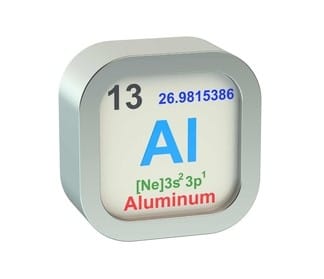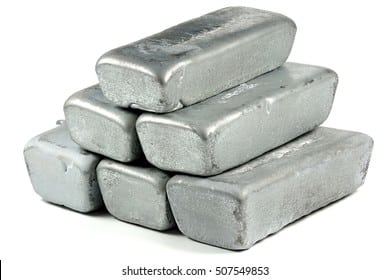Aluminum is a metal known for its high electrical conductivity. Though its conductivity is only 60% that of copper by volume, one pound of aluminum has the electrical current-carrying capacity of two pounds of copper by weight. Satellite dishes are frequently made of aluminum. Aluminum is used in high-voltage transmission lines that are encased in steel for added protection. However, in electrical connections, aluminum forms an electrically resistant oxide surface, which can cause the connection to overheat.

| Name of metal | Aluminum |
| Melting point | 660.3 °C |
| Density | 2.7 g/cm³ |
| Crystal structure | face-centered-cubic crystal structure |
| No of unbonded Electrons | 1 unpaired electron placed in a 3p orbital in its ground state |
| Electronic configuration | 1s22s22p63s23p1 |
| Is Aluminum conductive? | Yes |
| Aluminum molar mass | 26.982 g/mol |
Table of Contents
What is Aluminum?
Aluminum (United States English), also known as aluminum (British English), is the 13th element in the periodic table and is a silvery-white metal. One surprising fact about aluminum is that it is the most common metal on the planet, accounting for more than 8% of the Earth’s core mass. It is also the third most common chemical element on Earth, following oxygen and silicon.
Aluminum possesses a unique set of valuable properties. It is one of the lightest metals in the world, almost three times lighter than iron, but it is also very strong, extremely flexible, and corrosion resistant due to its surface being always covered in an extremely thin but extremely strong layer of an oxide film. Aluminum is not magnetic, but it is a good conductor of electricity and forms alloys with almost all other metals.
Aluminum conducts electricity in both the solid and liquid states due to metallic bonding between fixed positive Al(3+) ions and delocalized electrons. Due to the fact that delocalized electrons are free to move in both states, they are capable of carrying charge.
Aluminum does not attach to magnets in our experience (neither does copper). When exposed to high enough magnetic fields, most stuff will display some magnetic attraction. However, under normal conditions, aluminum does not appear to be magnetic. Check the full article “Is aluminum magnetic?”
Summary
- The answer to the question “is aluminum magnetic?” is yes. Aluminum conductivity is 60% that of copper by volume.
- Aluminum is not magnetic under normal conditions.
- Aluminum has many valuable properties. It is one of the world’s lightest metals, almost three times lighter than iron, but it is also very strong, flexible, and corrosion resistant due to a thin but extremely strong oxide film covering its surface.
Frequently Asked Questions
1. Is aluminum a good conductor of electricity?
Aluminum is well-known for its excellent electrical conductivity. Though its conductivity is just 60% that of copper by volume, one pound of aluminum has the electrical current-carrying capability of two pounds of copper by weight.
2. Does steel conduct electricity?
Steel has far poorer conductivity than ‘pure’ metals such as copper, silver, and gold, but because of its high iron component, it is a better conductor than other alloys such as brass.
3. Is aluminum a conductor or insulator?
Aluminum is excellent conductor of both heat and electricity. Because conductivity is mostly determined by the mobility of electrons in an atom, aluminum has a high conductivity due to the presence of free electrons in the valence shell.
4. Which is correct: aluminum or aluminum?
Aluminum is the preferred spelling in North America, but aluminum is the preferred spelling in the United Kingdom and most other English-speaking countries.
5. Aluminum charge?
An aluminum ion normally has a charge of 3+. This is due to the element’s atomic number of 13, which reflects the fact that it has 13 electrons and 13 protons. The valence shell of aluminum includes three electrons, and according to the octet rule, these three electrons are lost, leaving just ten electrons and thirteen protons.
6. Aluminum formula?
Aluminum’s chemical formula is Al. This compound has a molar mass of 26.98g/mol.
7. Aluminum oxide?
Aluminum oxide, having the chemical formula Al2O3, is an amphoteric oxide of aluminum. Alumina is another name for alumina.
8. PV diagram?
A PV diagram is a graph that shows the relationship between the system’s pressure P and volume V. The P-V diagram is used to calculate the amount of work done by or on the gas during expansion or compression.
9. Solar thermal power plant?
Aluminum has unique qualities such as lightweight, high strength, suitable corrosion properties, high surface reflectivity, outstanding electrical and thermal conductivities, and particular optic properties of its anodic coating that make it an inseparable component of solar thermal plants.
10. How is aluminum used in electric cars?
Aluminum, which is far lighter than steel, is currently used in a variety of sections, including the chassis, structural components such as the shock tower, and interior panels, as well as housing for motors and batteries that power electric vehicles. Check the related article “Alternative fuel vehicle”.
11. Does metal have a carbon footprint?
Steel production is very emission-intensive, with roughly 2 billion tonnes of steel produced each year accounting for around 8% of global CO2 emissions. Check another related article “What is carbon footprint”.
Related Topics
Is Titanium Magnetic?
Paramagnetic Materials
How many valence electrons does iron have?
How many electrons does Helium have?
Electric Field of Sphere of Uniform Charge
Magnetic Induction – An Overview
| Conduction in Physics| Easy Examples | Convection| Atmospheric Motions in the Vertical Direction |
| Aerosol| Introduction, Sources, and Uses | What Is Malleability in Metal? |
- BCl3 Lewis Structure in four simple steps - November 1, 2023
- PH3 Lewis Structure in four simple steps - October 8, 2023
- PF3 Lewis structure in four simple steps - September 24, 2023



